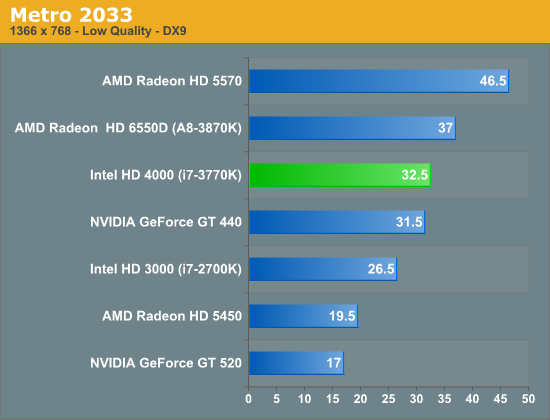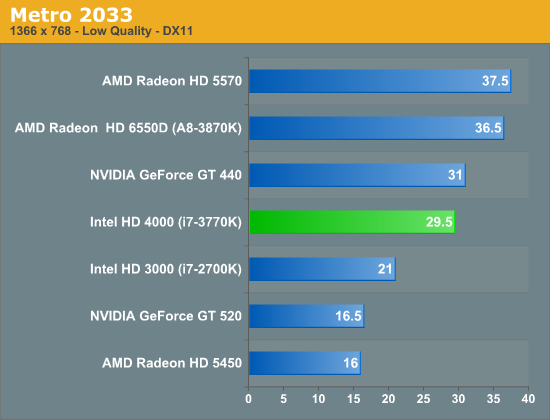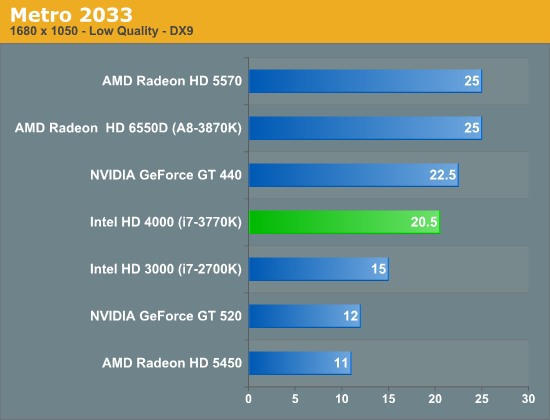The Intel Ivy Bridge (Core i7 3770K) Review
by Anand Lal Shimpi & Ryan Smith on April 23, 2012 12:03 PM EST- Posted in
- CPUs
- Intel
- Ivy Bridge
Our next graphics test is Metro 2033, another graphically challenging game. Since IVB is the first Intel GPU to feature DX11 capabilities, this is the first time an Intel GPU has been able to run Metro in DX11 mode. Like Crysis this is a game that is traditionally unplayable on Intel iGPUs, even in DX9 mode.



Here the Llano gap shrinks to about 13—25% depending on the resolution/quality settings. AMD still has the clear advantage in GPU performance, but Intel does step closer. The performance advantage over Sandy Bridge ranges from 20—40%. With these sorts of numbers it's clear why Intel views Ivy Bridge as being a tick+. Generational performance improvements on the CPU side generally fall in the 20—40% range. As you've just seen, Ivy Bridge offers a 7—15% increase in CPU performance over Sandy Bridge—making it a bonafide tick from a CPU perspective. The 20—40% increase on the graphics side is what blurs the line between a conventional tick and what we have with Ivy Bridge.










173 Comments
View All Comments
Tujan - Tuesday, April 24, 2012 - link
cause how I see it :" If you're constantly transcoding movies to get them onto your smartphone or tablet, you need Ivy Bridge. In less than 7 minutes, and with no impact to CPU usage, I was able to transcode a complete 130 minute 1080p video to an iPad friendly format—that's over 15x real time."
The majority of trancoding is going the other way- from an ipad friendly format to another friendly type format (device or not). Cell phone to pc,ipad to youtube etc.
I like the concept of the transcode,encode,but as much as with the bandwidth necesary to utilize them they are as they are 'bandwidth hungry'. And here is the first I have noticed that of telling there is hardware to facilitate the h.264 type encoding. "Hardware" to do this.
The screens from all of those cell phones in high resolution 'still'require bandwidth to utilize them. .. and so on.
I dont understand it completely but I'll attempt to stay tuned.
androticus - Tuesday, April 24, 2012 - link
I find this review enormously confusing. You mix IB and SB parts/sku's throughout, without clearly highlighting which is which. On page 2, at first I thought the chart was of IB CPUs, but then realized it was a mishmash of both. Likewise on all the benchmark charts, and I couldn't even distinguish various SB/IB/core counts apart.Was this article written solely for people who have a PhD in Intel sku's ???
Dudenell - Tuesday, April 24, 2012 - link
Could we actually see comparison with the i7-920 or i7-950 in there?Pjotr - Wednesday, April 25, 2012 - link
Thanks for the Compile test, this is all I look at to decide purchases at work.sld - Wednesday, April 25, 2012 - link
The A8 is conspicuously missing from the 2 charts showing idle and load system consumption. Why is this so?greggm2000 - Wednesday, April 25, 2012 - link
Anand/Ryan,According to the article linked below from today, it seems that Intel may be using TIM paste instead of fluxless solder in the IB chips, and if so, does this seem like a reasonable explanation for the high temperatures that people are seeing?
I'm interested in your thoughts on this... and if it's true, and if the article is correct, then Intel deliberately handicapping their chips (to possibly preserve SB-E sales?) is quite troubling to me.
http://www.overclockers.com/ivy-bridge-temperature...
slickr - Thursday, April 26, 2012 - link
Hi, is this good enough of an upgrade over a Pentium 4 for office, internet and movies?And will the HD4000 beat a ATI x1650XT?
Death666Angel - Friday, April 27, 2012 - link
Hey guys!Good review overall, thanks for that!
But the Quicksync section was kinda strange. No way that an x86 software solution generates worse IQ than any accelerated stuff. Unless you were comparing IQ with settings that have the x86 do recode the file in the same time it takes the other solutions. Anyway, I don't understand what you did in that section. :-)
kevith - Friday, April 27, 2012 - link
Great review.Would it be interesting to see how it fared in a series 6 motherboard, now that it actually is backwards compatible?
pwnsweet - Saturday, April 28, 2012 - link
The only thing I care about is how much faster this new slab of silicon will power though my x264 encoding and that's the one part of the review that was left out!Why anand, why!?